Hsiu-Jung Chou
Department of Business Administration, Cheng Shiu University, Kaohsiung, Taiwan
Correspondence to: Hsiu-Jung Chou, Department of Business Administration, Cheng Shiu University, Kaohsiung, Taiwan.
| Email: |  |
Copyright © 2017 Scientific & Academic Publishing. All Rights Reserved.
This work is licensed under the Creative Commons Attribution International License (CC BY).
http://creativecommons.org/licenses/by/4.0/

Abstract
Described is a creative product developed on the basis of structure and defects of traditional cutting boards for space saving, storage and dispensing with diverse functions as the main concept of invention that has obtained the ROC Utility Model Patent M502436. The product comprises of a body, a chopping board and drawer parts with the chopping board on the body of the cutting board and the auxiliary cooking appliance (a box and a peeler or dicer) at one side of the body. The body and auxiliary cooking appliance are both equipped with storage drawers and water pans at the bottom with the storage drawers having multiple plates for customized adjustment of users and classified storage of food materials after chopping and peeling while the bottom plates of storage drawers have a plurality of holes to drain food. The innovative idea of the invention is an integration of cutting board, storage drawers, drainage function and auxiliary appliances as a solution to problems of modern kitchens, such as lack of space or excessive space use of dishes, etc.
Keywords:
Cutting board, Peeler, Patent, Creative invention
Cite this paper: Hsiu-Jung Chou, Creative Invention Cases of Multi-purpose Cutting Board, Science and Technology, Vol. 7 No. 3, 2017, pp. 79-88. doi: 10.5923/j.scit.20170703.03.
1. Research Background and Purposes
With technology developing rapidly, people have relatively high demand for food. To prepare cuisine with great look and taste, cutting board is one of the essential tools for cooking. Based on the opinions above, a "multi-purpose cutting board" was invented which not only maintain traditional cutting board's function of chopping food but protect kitchen counter or table from scratches. Additionally, in combination with the storage and dispensing concepts, when using the product, users can easily place the chopped food materials into drawers to remove the limitation of insufficient space or prevent different food materials from mixing together in the same dish while the auxiliary cooking design offer convenience to users in using peeler in the process. The product brings about various benefits and improves the defects of traditional cutting board.Traditional cutting board has simple structure as well as function as a board for chopping food materials that are usually placed in various dishes and placed on the kitchen counter. Since the space of modern kitchen is limited, it is relatively inconvenient when a number of dishes are placed on the kitchen counter. To improve the cooking environment and solve the problem of placing an excessive number of dishes in such limited space, the invention is a further improvement of traditional cutting board which improves the structure and repairs the defects of traditional cutting board. With the "innovative" and "creative" design, it is a practical product of diverse functions that raises space utilization in order to minimize the inconvenience in cooking. When chopping, the water of food materials is likely to flow onto the kitchen counter, making the surface damp and dirty and requiring plenty of time in follow-up cleaning so that the kitchen can remain clean and tidy. Meanwhile, multiple dishes are required to hold the food materials after processing, which occupy the space of kitchen. However, due to the simple design of peeler, it is difficult to collect food materials after peeling, resulting in waste of food. Therefore, with the innovative design of "multi-purpose cutting board", the body of the cutting board and the auxiliary cooking appliance are equipped with storage interlayers and water pans. The interlayers are used for adjusting storage space according to user's requirements so that the chopped or peeled food materials can be further classified and stored in drawers. The food materials can be easily taken from the drawers for cooking. Besides, the storage layers have multiple small holes at the bottom to drain the excess water of foods and avoid germs due to improper reservation of food materials. At present, traditional cutting boards in the market are made of a variety of materials that fit different cooking methods and food materials. On that basis, each household often has one or two types of cutting boards for alternative use, occupying space and making the kitchen cramped with dishes filled with chopped food materials. Since ancient times, cutting board has always been an essential tool for household. However, the dull and inflexible use of cooking tools inevitably makes people feel restless for cooking in the hustle and bustle of modern life. With the creative design of multi-purpose cutting board, the multifunction and diversified combination is expected to add enjoyment of cooking in life.
2. Literature Review
In daily life, cutting board is not merely a tool for chopping food materials. The invention is expected to offer convenience of storage and save space of kitchen in the modern society and through combination with storage drawers as well as auxiliary cooking tools, further avoid placing an excessive number of dishes to hold food materials, address the difficulties in finding cooking materials and relieving the damp and disorder situation of chopping in order to improve the overall environment of kitchen in respect of cleanliness, tidiness and comfortableness and make the best of space utilization.
2.1. Basis of Innovation
Inventions are solutions to inconvenience in life. Therefore, creative invention is required to jump out of the existing box, get rid of the existing limitations of logical thinking and make innovative attempts by close observation of details in daily life, different views of matters and development of unique and creative ideas to eventually produce inventions for the convenience and betterment of life. Creativity is a process of reconstruction of ideas originating from your existing perceptions to change the existing subjects, making them increasingly interesting. The inherent difference between human beings and other creatures lies in the fact that human beings are able to make good application of their thinking ability as well as creativity to continuously produce new inventions for betterment through numerous attempts. In fact, almost all great works come into being because of the inconvenience and inspiration in life (Weng, 2011). The English term "innovation" originates from Latin with three layers of original connotation: renewal, meaning change of the original; creation of something new, meaning creation of something that does not exist before; change, meaning development or renovation of the original. Product innovation can be defined as development of products showing the characteristics of innovation, value, practicability, suitability or other significance. Innovation is defined on the basis of comparison between such products and the existing similar ones while value is defined on the basis of benefits or significance of such products to a certain group of people (Liu, 2011). Previous studies on product innovation mainly focused on enterprises of developed countries. Considering the current changing global economic environment in the era of globalization, enterprises are pursuing innovation and breakthroughs and the emerging economies are part of the important economic force. In such situation, enterprises tend to concentrate themselves on active attempts to achieve innovation and seek new way to success and development. Because there is a wide range of product innovation of emerging economies and the "BRIC" countries, namely China, India, Russia and Brazil, are situated in Asia, Taiwan has the best geographical location standing next to the emerging markets and having good technology for independent development and innovation of enterprises thanks to the favorable management advantage as the foundation for innovation (Teng and Hsu, 2015). The creative product, "multi-purpose cutting board", is an improvement in structural defects of the existing cutting board. It is an invention that facilitates cooking with appropriate space utilization, convenient storage of food materials and diverse functions, offering a new option for dining teachers in accordance with economic benefits, reduction of costs and practical value as the concept and goal of the invention.
2.2. Relevant Studies on Cutting Board
Cutting board is one of the important tools for cooking. Cutting boards are made of wood, plastic, bamboo or tempered glass. Cutting boards made of different materials have their own advantages and disadvantages. An introduction of common cutting board materials is provided as follow:
2.2.1. Wooden Cutting Board
Wooden cutting board is the most commonly used product. It is usually relatively heavy and has strong tenacity, making it an ideal option for cutting meat and bones. Generally speaking, the wood that only goes through simple processing before it is put into production of cutting boards is likely to breed bacteria and have cracks as well as wood chips. (1) Advantage: Suitable for chopping and cutting foods (e.g. preparing fish or meat dishes). (2) Disadvantage: Easy to get mildewed and have filth, relatively heavy.
2.2.2. Plastic Cutting Board
Plastic cutting board is light, easy to clean, convenient for storage and excellent in mold resistance. However, it cannot resist high temperature and easily gives away to pressure. There are two types of plastic cutting boards respectively made of PE and PP materials. The PE cutting boards have different colors. Thicker ones are combination of multiple layers. These cutting boards are cheaper. In contrast, PP cutting boards have higher density and all are one-piece cutting boards only in white and more expensive than the PE materials. (1) Advantage: Easy to clean, relatively light. (2) Disadvantage: Easy to slide.
2.2.3. Tempered-glass Cutting Board
Tempered-glass cutting board is not applicable to chopping vegetables and meat but suitable for cutting fruits and bread; the cutting board has nice appearance and can be directly used as a tray to serve guests after cutting. Glass cutting boards generally have small patterns to prevent food materials from sliding. (1) Advantage: Suitable for cutting fruits without scratches, easy to clean.(2) Disadvantage: High rigidity, easy to damage knives in case of chopping.
2.2.4. Bamboo Cutting Board
Except cutting or chopping hard, bamboo cutting board is recommended because compared to wooden cutting board, it is easier to clean and not likely to go mildewed or have cracks and it is lighter than wooden cutting board. (1) Advantage: Easy to clean, high temperature resistance, not easy to crack compared to wooden cutting board. (2) Disadvantage: Relatively high rigidity, making loud noise when in use, easy to damage knives; since bamboo is relatively thin, some products may have plenty of gaps that are easy to breed bacteria.Most people take "material" as the first priority when purchasing cutting boards. Different materials are applicable to different occasions and users should purchase cutting boards according to the characteristics of food materials and their cooking demands (iRead, 2016). Users had better select cutting boards based on their cooking habits and frequency. For those cooking at home every day, wooden cutting board is the best option while for those frequently eating out and only cutting fruits or preparing simple meals at home, plastic or tempered-glass cutting board is an ideal choice (4F Cooking Home, 2012).
2.3. Overview of Marketing Strategy
With the society changing rapidly, there are various emerging marketing channels. Therefore, in this study, relevant marketing strategies and theories were applied to analysis in order to discuss the marketing market of cutting board. Marketing channel refers to a set of interdependent organization of joint participation in promotion of use or consumption of products or services. Marketing channel is used for delivering manufacturers' products to consumers. Marketing is an organizational function as well as a series of procedures for creation of value, communication with and conveyance of such value to customers and management of customer relationship in order to benefit the organization and relevant interested persons. Marketing management is an art and science for target market selection, obtainment and maintenance, increase of customers and superior customer value through creation, delivery and communication (Lo, 2012).
2.3.1. SWOT Analysis
SWOT means an overall analysis on the strengths, weakness, opportunities and threats of an enterprise that is relating to monitoring of such company's internal and external marketing environment. Internal environment analysis means analysis on strengths and weakness. Each enterprise needs to assess its own internal strengths and weakness to discover attractive marketing opportunities for the enterprise. External environment analysis means analysis on opportunities and threats. An enterprise must monitor the overall environmental force and specific environmental factors having significant influence on its profitability. Business entities must set up marketing information systems to follow market trends, important development situation as well as relevant opportunities and threats.
2.3.2. Marketing Strategy (STP Analysis)
All marketing strategies are formulated on the basis of STP analysis comprising of market segmentation, target market and market positioning. Companies are required to explore different demands and groups in the market for positioning of products according to the demands of certain groups that such companies are able to meet in a satisfactory way in order to obtain recognition for the companies' special products and image in the target market (Lo, 2012). (1) SegmentationMarket segmentation is the process of diving a market into segments of complete definitions. Each segment comprises of a group of customers having similar demands and needs. The key lies in making adjustments to marketing strategies to obtain profounder understandings of differences among customers. For effective division of market, market segmentation must show measurability, substantiality, accessibility, differentiation and feasibility. (2) Target marketTarget market means identification of target customers of products or services provided by companies and enterprises where consumers are regarded as a specific group. However, marketing personnel must take social responsibility into consideration when selecting target market. (3) PositioningMarket positioning is design of products and image of a company that are recognized by target consumers as a special subject, aiming at wide acceptance of customers and maximization of potential benefit of the company. A good brand positioning can clearly demonstrate the essence of the brand, effectively facilitate consumers to achieve their goals and show its uniqueness, offering guidance to marketing strategies. Every member of an organization should be well aware of brand positioning and regard it as the basis for making all marketing decisions. Customer-oriented value is the outcome of successful positioning.
2.3.3. Marketing Mix (4Ps Analysis)
Various marketing events were divided by marketing scholar McCarthy into four major types, namely the 4Ps of marketing: product, price, place and promotion, referred to as marketing mix (Lo, 2012).(1) ProductA product refers to an item that satisfies the consumer's needs or facilitates the enterprise's achievement of goals. A product can be tangible in the form of goods or intangible in the form of a service. (2) PricePrice refers to the amount a customer pays for a required product or service. (3) PlacePlace is also called distribution. It refers to the channels used by producers for delivering products or services to ordinary consumers directly or by the intermediary. (4) PromotionGenerally speaking, enterprises carry out promotion in the form of sales, advertising and PR, etc.
3. Description of Technical Design
3.1. Technical Content
The invention "multi-purpose cutting board" (Patent No. M502436) achieves its structural purpose and functions through the techniques below: The product comprises of a body, a chopping board and drawer parts with the chopping board on the body of the cutting board and the auxiliary cooking appliance (a box and a peeler or dicer) at one side of the body. The body and auxiliary cooking appliance are both equipped with storage drawers and water pans at the bottom with the storage drawers having multiple plates for customized adjustment of users and classified storage of food materials after chopping and peeling while the bottom plates of storage drawers have a plurality of holes to drain food. Based on different properties of food materials, the invention is a one-piece design of cutting board, storage drawers, drainage function and auxiliary appliances as a solution to problems of modern kitchens, such as lack of space or excessive space use of dishes, etc. by preventing overuse of dishes and raising the space utilization, which, in the meanwhile, fulfills the purpose of realizing "various benefits", "practicability" and "value" and meet users' demand for saving space of kitchen as well as food storage, achieving the ultimate goal of the inventor through the above-mentioned functions.
3.2. Techniques
The invention "multi-purpose cutting board" is actually an integration of cutting board, storage drawers, drainage function and auxiliary appliances. The multi-purpose cutting board is a one-piece cooking tool comprising of a body, a chopping board and drawer parts with the chopping board on the body of the cutting board and the auxiliary cooking appliance at one side of the body so that users can use the cutting board according to specific occasions through diverse combination and application, which not only reflects economic benefit by reducing costs of purchasing extra tools but also minimize the inconvenience of previous cooking and relieve the stress of a crowded kitchen by replacing the traditional cutting board with the invention with diverse functions. Through sales in hypermarkets and TV shopping, the product aims at the market of housewives to increase market share and popularity. For details of change of combination and schematic diagram of operation, please refer to Table 1 and Figures 1 to 12 describing the changes of operation and benefits of the cutting board.Table 1
 |
| |
|
(1) The body of cutting board shown in Figure 1 and cooking appliances shown in Figure 2 constitute the multi-purpose cutting board shown in Figure 3 (as shown in Table 1). (2) Figure 4 is the body of cutting board (including a chopping board, drawer parts, storage drawers and a water pan). (3) Figure 5 is the schematic diagram of using the chopping board for cutting food materials. (4) Figure 6 is the schematic diagram of placing food materials into the interlayer of storage drawer. (5) Figure 7 shows that the chopping board has pulleys at the bottom for sliding. (6) Figure 8 shows that the body is equipped with safety lock at its side to prevent the chopping board from sliding when chopping. (7) Figure 9 shows the auxiliary cooking appliance (including a box and a peeler or dicer). (8) Figure 10 is the schematic diagram of using the auxiliary appliances for peeling.(9) Figure 11 is the schematic diagram of the peeled off food materials falling into the storage drawer. (10) Figure 12 shows that the interlayers of the storage drawer can be adjusted according to user's need.  | Figure 4. Body of Cutting Board |
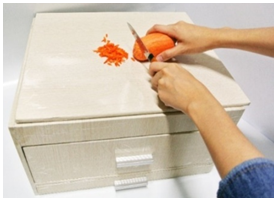 | Figure 5. Schematic Diagram of Chopping Food Materials on Chopping Board |
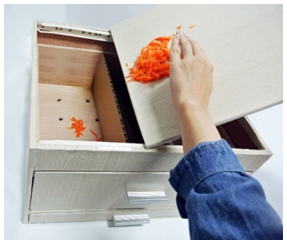 | Figure 6. Schematic Diagram of Food Materials Falling into Interlayer of Storage Drawer |
 | Figure 7. Design of Pulleys |
 | Figure 8. Safety Lock |
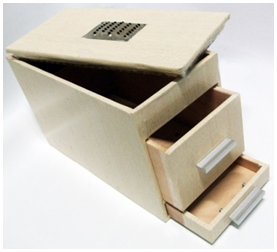 | Figure 9. Auxiliary Cooking Appliances |
 | Figure 10. Schematic Diagram of Peeling with Auxiliary Appliance |
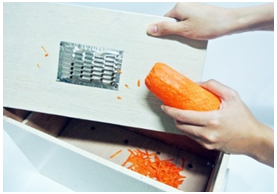 | Figure 11. Schematic Diagram of Peeled off Food Materials Falling into Storage Drawer |
 | Figure 12. Adjustable Interlayers of Storage Drawer According to User's Need |
4. Patent Description
4.1. Patent
The traditional cutting boards in the market are generally used as a chopping board for cutting food materials with relatively simple functions. When the food materials are cut or chopped, plenty of dishes are required to hold these materials, occupying a large space of the kitchen and causing great inconvenience in the process. The main structure of the invention has excellent "purpose of invention" and "innovative idea" which is comprehensively described as follows so that users can obtain profounder and elaborate understandings of the invention. From the elaborate and profounder description above, the advantages of the upgraded product lie in:(1) Space saving(2) Convenient for storage(3) Multifunction(4) Diversification(5) Simple application
4.2. Description of Main Elements
(1) Figure 13 Exploded Pictorial Diagram of Multi-purpose Cutting Board. (2) Figure 14 Exploded Assembly Diagram of Multi-purpose Cutting Board. (3) Figure 15 Schematic Diagram of Cutting Board in Service Condition of Chopping and Cutting. (4) Figure 16 Schematic Diagram of Pushing Food Materials into Storage Drawer in Service Condition. (5) Figure 17 Schematic Diagram of Pulling out Drawer Part. (6) Figure 18 Schematic Diagram of Removing Rear Board of Drawer Part. (7) Figure 19 Schematic Diagram of Auxiliary Cooking Appliance under the First Implementation Condition. (8) Figure 20 Schematic Diagram of Auxiliary Cooking Appliance under the Second Implementation Condition. 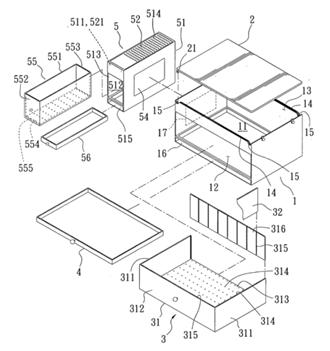 | Figure 13. Exploded Pictorial Diagram of Multi-purpose Cutting Board |
 | Figure 14. Exploded Assembly Diagram of Multi-purpose Cutting Board |
 | Figure 15. Schematic Diagram of Cutting Board in Service Condition of Chopping and Cutting |
 | Figure 16. Schematic Diagram of Pushing Food Materials into Storage Drawer in Service Condition |
 | Figure 17. Schematic Diagram of Pulling out Drawer Part |
 | Figure 18. Schematic Diagram of Removing Rear Board of Drawer Part |
 | Figure 19. Schematic Diagram of Auxiliary Cooking Appliance under the First Implementation Condition |
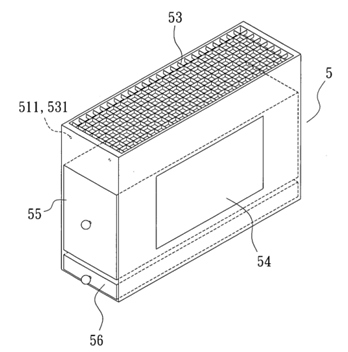 | Figure 20. Schematic Diagram of Auxiliary Cooking Appliance under the Second Implementation Condition |
4.3. SWOT Analysis
4.3.1. Strengths
Traditional cutting boards are merely design for cutting and chopping food materials that prevent damage of the kitchen counter or table. To solve the problems of excessive dishes for holding food materials during preparation and insufficient table space in cooking, etc. the invention is an integration of multifunction that avoids occupation of large space and increases storage efficiency. Further, the "multi-purpose cutting board" is designed as an improvement in the structure and defects of traditional cutting boards. According to the cutting methods, characteristics, capacity and size of different food materials, the integration of cutting board, storage drawer, drainage function and auxiliary cooking appliance is developed to achieve multiple benefits at the same time, prevent excessive use of dishes to hold the food materials after cutting and chopping, reduce the utilization of dishes but increase that of space and minimize the inconvenience for cooking. The invention has the following advantages: (1) Storage function: The storage drawer is designed for food materials after cutting and chopping. (2) Multifunction: A cutting board and a peeler are available. (3) Diversification: The body of the cutting board and the auxiliary cooking appliance are combined by means of magnets and therefore it is easy for detachment and assembly, achieve the benefit of saving space. (4) Safety protection: The invention is equipped with safety lock to prevent the cutting board from sliding or hurting users when in use.(5) Flexibility: The storage drawer has multiple plates for space adjustment according to user's need.
4.3.2. Weaknesses
Since the invention is relatively large, it is not portable for outdoor use. The weakness of the invention is as follows: (1) Materials of the cutting board is limited and users cannot select their favorable materials according to the features of food materials. (2) It is difficult to clean the cutting board because the one-piece design is relatively inconvenient for cleaning.
4.3.3. Opportunities
In addition to independent preparation, the user's family can also get involved in the process, making it an interesting process; because housewives are usually shrewd in money matters, purchasing the multi-purpose cutting board is a good option without extra cost of purchasing other auxiliary cooking appliances. The invention can also be used based on cooperation with construction companies in which case the multi-purpose cutting board can be included as part of decoration and design of kitchen, forming the conception of systematic kitchen appliances. Opportunities for the invention include: (1) Enormous target market. (2) Innovation and multifunction. (3) Customized sizes and patterns.
4.3.4. Threats
Every family or user is loyal to the traditional cutting board to some extent. Therefore, it is relatively challenging for the multi-purpose cutting board to replace the traditional ones and accepted by the market. Threats to the invention include: (1) Consumers' loyalty to the existing traditional cutting board in the market. (2) Diverse options and various sales channels of cutting boards.
4.4. Marketing Strategy Analysis
4.4.1. Segmentation
(1) Change of population: With time changing, the typical breadwinner-homemaker family mode is fading away and both men and women can be chefs. Therefore, the product mainly targets at housewives, chefs and campus catering teaching as well as customers interested in cooking in their spare time. (2) Change of mindset: The invention save the space of placing dishes to hold food materials and facilitate the maintenance of a clean environment for cooking. The design of auxiliary cooking appliance also solves the problems of difficult to find peeler in the cooking process while the water pan is designed as a solution to thoroughly drain the water for cleaning food materials. (3) Change of behavior: In addition to benefits and innovation, extremely high requirements are imposed for saving space of kitchen and storage of food materials in order to boost users' loyalty for the practical cooking appliance.
4.4.2. Target Market
(1) Primary target market: Market of housewives, chefs and campus catering teaching. (2) Secondary target market: Customers interested in cooking in spare time.
4.4.3. Positioning
For those who cook frequently, the diversification, simple operation and convenient storage design that minimize the inconvenience of cooking and this is the marketing positioning of the cutting board.
4.5. Marketing Mix Analysis
4.5.1. Product Analysis
As long as consumers purchase the "multi-purpose cutting board", regardless of the kitchen area, they are sure to be provided with a comfortable and convenient environment of use, multifunction and added values. According to the concept of preparing fish according to different recipes, the cutting board, storage space, drainage function, water pan and auxiliary appliance are combined together as an integration to solve the problems of excessive placement of dishes to hold food materials and prevent contamination of food materials in the air. The storage space has holes at the bottom to drain excess eater and ensure that the kitchen counter or table remains clean.
4.5.2. Price Analysis
To satisfy users' needs and different occasions, users can purchase the product according to their own needs. There are two prices: (1) Basic: The cutting boards are put into mass production with certain specifications, indicating low profits with the relatively low price. (2) Customized: The cutting boards are customized according to users' requirements for specifications. Compared to the basic cutting boards, these customized ones are more expensive, showing a comparatively high profit.
4.5.3. Place Analysis
(1) Physical channelsa. Exclusive shop: Physical shops can be set up to attract consumers to choose and experience the product in person. Staff of physical outlets should provide one-to-one customer service to answer customers' questions and recommend products according to customers' need. b. Hypermarket: In the busy modern life, hypermarkets are usually established in prosperous areas having convenient traffic conditions and various commodities for sale. To purchase the needed commodities conveniently in a short time, most consumers tend to shop in hypermarkets. c. Supermarket: Supermarkets have multiple product lines and a variety of products, mainly including daily necessities. d. Construction company: Based on cooperation with construction companies, the multi-purpose cutting board can be directly used as part of the decoration and design of kitchen and displayed as a systematic cooking appliance, in which way, the comfortable large cooking space is created. (2) Virtual channelsVirtual channels include official website, community fan page, online shopping website and TV shopping, etc. a. Online sales: With the advanced technology, many entrepreneurs combine physical outlets and virtual channels for business operation and consider the online platform as one of the sales channels. Special official website and Facebook fan page are established, offering online instant communication with consumers. Through online marketing, the invention can obtain much visibility rapidly. b. TV shopping: Since each household at least has a television, TV shopping channels offer flexible schedules to customers for shopping. In addition, TV advertising is also an ideal option to attract consumers to purchase the product.
4.5.4. Promotion Analysis
The invention is expected to increase its popularity by means of the promotion methods below: (1) Establishment of an official website and community fan page for interaction. (2) Newspaper features and advertising. (3) Word-of-mouth marketing. (4) Participation in cooker exhibitions and appointment of celebrity chef as speaker.
5. Conclusions
The invention is a creative idea originating from daily life. The inventor noticed that the family used plenty of dishes to hold food materials after chopping and cutting when preparing food in a small space and the dishes on the kitchen counter caused great inconvenience in searching cooking appliances. In order to provide an easy and comfortable cooking environment for housewives and cook busy preparing food for their families every day and make proper use of space, the "multi-purpose cutting board" of multifunction and convenient for storage is invented. With such multi-purpose cutting board, users are provided with multifunctional cooking appliances that, under all occasions or preparing foods with any materials, satisfy users' need and only occupy a limited space of the kitchen. Users can prepare foods in an easier and more convenient way and search and use peeler or dicer conveniently without efforts. Considering the high property price in the current densely populated areas, the residential space is considerably limited. Meanwhile, in the economic downturn, the invention can ease users' financial burden by sparing the expense for purchasing extra cooking appliances. The invention not only overcomes the weakness of the existing traditional cutting boards, but add new functions different from those of the previous cutting boards. The above-mentioned descriptions of elements and implementation of the invention indicate that the invention, compared to the traditional cutting board structures, has the following advantages: (1) The body of the cutting board has pulleys. After cutting and chopping, the cutting board with pulleys rolls along and it is lifted and pulled outward with force to push the food materials into the storage drawer under the cutting board to prevent the materials from contamination in the air before cooking. (2) The invention is equipped with safety lock to prevent the cutting board from sliding or hurting users when in use. (3) The storage drawer under the cutting board has multiple plates for space adjustment according to user's need. (4) The body of the cutting board and the auxiliary cooking appliance are combined by means of magnets. To use the auxiliary cooking appliance, it is easy to assemble it to one side of the body; when not in use, it can be detached to avoid excess space utilization. (5) When using the auxiliary cooking appliance, food materials will be pushed into the drawer under the cutting board to prevent waste of food. (6) The storage drawers of the body and the auxiliary cooking appliance have multiple small holes at the bottom to drain excess water of food materials and the water pans under the drawers are designed for collecting such water to prevent the water for cleaning food materials logging in to drawers from adversely affecting the sanitation of food materials. The invention has obtained a utility model patent and has been selected to participate in a number of domestic and international invention-related competitions. It has won 1 award of excellent invention, 1 bronze medal, 1 award of excellent work and 1 award of creativity in the domestic competitions while it has been awarded three gold, silver and bronze medals in the international competitions. Through the participation in various competitions and invention exhibitions, the product is exposed to the channels connected to consumers. Therefore, it is an effective way to gain popularity and obtain feedback for improvement by handing out leaflets; in the future, the inventor is looking forward to negotiation with relevant manufacturers in respect of technology transfer and commodification of development and cooperation as well as raising the value of commodity through modifications. It is expected that the design of "multi-purpose cutting board" can create an ideal cooking environment with the detachable cutting board and auxiliary cooking appliance as well as the convenient storage function to further improve the cleanliness of food and environment, raise the space utilization of kitchen and offer higher level of convenience to the cooking process.
References
| [1] | 4F Cooking Home (2012). Tips on Cutting Boards. Retrieved from: https://the4fcookinghome.squarespace.com/kitchen-tips/2012/10/blog-post27. |
| [2] | Cheng Shiu University (2015). Patent No. M502436, Taipei: Intellectual Property Office, Ministry of Economic Affairs. |
| [3] | iRead (2016). Wooden, Bamboo, Plastic, Glass Cutting Boards, Which Is Better?. Retrieved from: https://read01.com/5nd36G.html. |
| [4] | Liu, H.C. (2011). A Product Metaphor Model for Innovative Design, Thesis of Institute of Innovative Design, National Taipei University of Technology, 1-83. |
| [5] | Lo, S.K. (trans.) (2012). Marketing Management (Kotler & Kevin Lane Keller), Dong Hua Books, Taipei, 1st ed., 27-486. |
| [6] | Teng, W. L., and Hsu, Y. (2015). Discussion on Product Innovation of New Economies, Industrial Design, 131, 1-7. |
| [7] | Weng, R. M. (2011). Discover Creative Ideas-- Discussion on Learning Strategies for Developing Creative Inventions, The Educator Monthly, 527, 37-39. |




















 Abstract
Abstract Reference
Reference Full-Text PDF
Full-Text PDF Full-text HTML
Full-text HTML